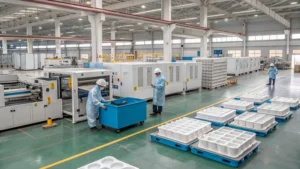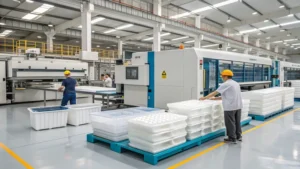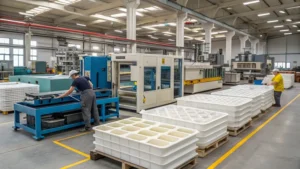
Vacuum forming is a versatile manufacturing process1 that heats a plastic sheet until pliable, then uses vacuum pressure to shape it over a mold, creating parts for industries like packaging and automotive.
Vacuum forming uses heat and vacuum pressure to shape plastic sheets2 over molds, producing cost-effective parts for packaging, automotive, and more, with material choice impacting success.
Selecting the right plastic is critical to achieving the desired performance and quality in 진공 성형3. This blog post explores common plastics, key factors for selection, the process itself, comparisons to other methods, and practical tips to guide your decision.
ABS is the most commonly used plastic for vacuum forming.True
ABS is widely used due to its balance of strength, cost, and ease of forming.
진공 성형은 소량 생산에만 적합합니다.False
While often used for low to medium volumes, vacuum forming can also support higher volumes with the right setup and materials.
What are the Common Plastics Used in Vacuum Forming?
The choice of plastic in vacuum forming affects the part’s strength, clarity, and cost, making material selection a key step in the process.
공통 vacuum forming plastics4 include ABS, HIPS, PETG, PVC, Acrylic, and Polycarbonate, each offering unique properties for applications like packaging, signage, and automotive parts.

Here’s a breakdown of the most popular plastics:
아크릴로니트릴 부타디엔 스티렌(ABS)
ABS is strong, rigid, and impact-resistant, making it ideal for automotive parts, enclosures, and consumer goods. It’s easy to form and offers good dimensional stability.
고충격 폴리스티렌(HIPS)
HIPS is cost-effective with decent impact strength and rigidity. It’s commonly used for packaging, signage, and disposable products but has lower temperature resistance.

폴리에틸렌 테레프탈레이트 글리콜(PETG)
PETG is clear, FDA-approved, and recyclable, with good impact resistance. It’s used in food packaging, medical devices, and displays.
폴리염화비닐(PVC)
PVC is strong and chemically resistant, suitable for durable outdoor signage and construction materials. It can be trickier to form than other plastics.
아크릴(PMMA)
Acrylic offers excellent clarity and weatherability, perfect for signage, displays, and lighting fixtures, though it’s brittle and less impact-resistant.

폴리카보네이트(PC)
Polycarbonate is highly durable and heat-resistant, used in safety shields and machine guards. It’s costly and challenging to form.
| 플라스틱 | 힘 | Clarity | Temperature Resistance | 비용 | 일반적인 애플리케이션 |
|---|---|---|---|---|---|
| ABS | 높음 | Opaque | Medium | Medium | 자동차 부품, 인클로저 |
| HIPS | Medium | Opaque | 낮음 | 낮음 | 포장, 사이니지 |
| PETG | Medium | Clear | Medium | 높음 | Food packaging, medical devices |
| PVC | 높음 | Opaque | Medium | 낮음 | Outdoor signage, construction |
| Acrylic | Medium | Clear | Medium | 높음 | Signage, displays |
| 폴리카보네이트 | 매우 높음 | Clear | 높음 | 높음 | Safety shields, machine guards |
What are the Factors to Consider When Choosing a Plastic?
Selecting a plastic for vacuum forming requires balancing several factors to meet project needs.
Key factors in choosing a vacuum forming plastic include part requirements, 생산량5, budget, formability, and environmental considerations6.

-
Part Requirements: Assess strength, clarity, or temperature resistance needs.
-
생산량: Vacuum forming suits low to medium runs (250-3000 units/year).
-
예산: Balance cost (e.g., low-cost HIPS vs. pricey polycarbonate) with performance.
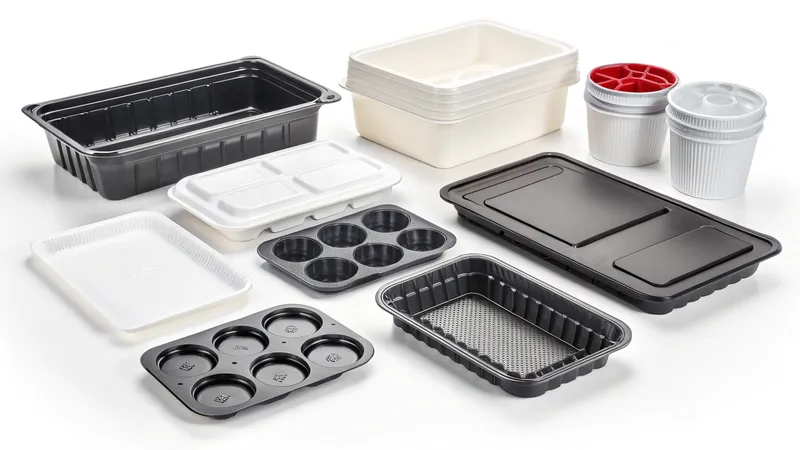
-
성형성: Easier plastics like ABS suit beginners; complex parts may need PETG.
-
환경적 요인: FDA-approved PETG works for food packaging.
진공 성형 공정에는 어떤 단계가 있나요?
Understanding the process highlights how plastic choice impacts results.
Vacuum forming heats a plastic sheet, stretches it over a mold, applies vacuum pressure, cools, and trims it, with plastic properties7 affecting each step.
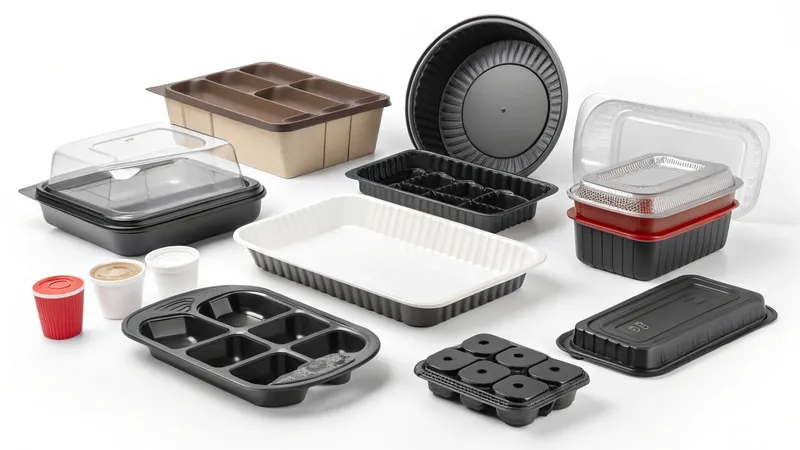
-
Stretching: The sheet is stretched over a mold (wood, aluminum, etc.).
-
진공 애플리케이션: Vacuum pulls the plastic against the mold.
-
냉각: The part cools to set its shape, with timing varying by plastic.
-
트리밍: Excess material is removed, and finishing is applied.
Plastic properties like forming temperature and cooling rate influence outcomes.
How Does Vacuum Forming Compare to Other Processes?
Comparing vacuum forming to alternatives clarifies its advantages.
Vacuum forming excels in low to medium volumes and large parts compared to injection molding, which suits high volumes and complex shapes.

-
Vs. 사출 성형: Vacuum forming is cheaper for low volumes; 사출 성형9 offers precision for high volumes.
-
Vs. Blow Molding: Vacuum forming suits solid parts; 블로우 성형10 is for hollow items.
What are the Practical Tips for Selecting the Right Plastic?
These tips streamline your decision-making process.
Choose a vacuum forming plastic by defining part needs, assessing volume, evaluating formability, considering environment, balancing cost, and testing options.

-
Define part requirements first.
-
Match plastic to production volume (e.g., HIPS for small runs).
-
Pick easy-to-form plastics if new to the process.
-
Consider environmental exposure (e.g., PVC for weather resistance).
-
Test plastics on a small scale if possible.
Explore resources like Toolcraft’s Material Guide.
결론
Choosing the right plastic for vacuum forming is essential for quality results. By understanding plastics like ABS, HIPS, and PETG, evaluating key factors, and applying practical tips, you can optimize your project. Vacuum forming’s versatility shines with the right material choice.
-
Learn about the essential steps in the vacuum forming process to improve your understanding of this efficient manufacturing technique. ↩
-
Discover the best types of plastic sheets for vacuum forming to ensure quality and performance in your projects. ↩
-
이 링크를 통해 진공 성형 공정과 다양한 산업에서의 응용 분야를 이해하고 제조 기술에 대한 지식을 향상하세요. ↩
-
Explore this link to understand the various vacuum forming plastics and their specific applications, enhancing your material selection process. ↩
-
Exploring this topic can help you optimize material selection based on your production needs. ↩
-
This resource will provide insights into sustainable practices in plastic selection for vacuum forming. ↩
-
Understanding plastic properties is crucial for optimizing manufacturing; this resource will enhance your knowledge on the topic. ↩
-
Learn about forming temperature and its significance in plastic processing to improve your production techniques. ↩
-
Learn about the differences between injection molding and vacuum forming to make informed production choices. ↩
-
Discover the unique aspects of blow molding and its applications compared to vacuum forming. ↩



